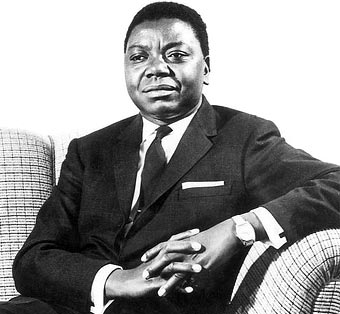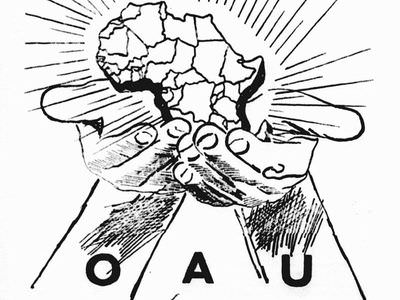The drawing (year, origin and purpose unknown) stands in stark contrast with the actual impact the Organisation of African Unity had on many African conflicts. While the hands seem to protect a continent that is shining bright, holding it high gloriously, their ability to put this into practice turned out to be limited. The drawing can also be interpreted, in this context, as representing the divergence between the OAU’S ideals of solidarity and security and at the same time their grab for influence and power, presenting the continent to foreign interests.
While their impact in the Congo Crisis remained negligible, it is nevertheless an interesting case to investigate why and how the organisation failed to bring about a solution. It was one of the first problems the African continent was confronted with shortly after the OAU’s creation, and could have been their chance to find “African solutions to African problems”, one of the norms underpinning their approach to dispute settlement. Furthermore, it adds another aspect to the project of understanding the Congo Crisis.
It is important to keep in mind that the OAU did not even exist until 1963, when the first part of the crisis, the assassination of Lumumba and the Katanga secession, was already over. However, the Simba “rebellions”, leftist lumumbist uprisings against the Tshombe government, which rooted in the political crisis of the foregoing years, as well as the appointment of Tshombe as interim primeminister, threw the Congo into turmoil once again. This could have been a first opportunity for the OAU to show their abilities as conflict resolvers, but unfortunately failed for a number of reasons.
Reasons for the OAU’s inability to find an “African solution” can be found in the Charter, in the kind of conflict the Congo Crisis was and in the lack of cooperation expressed by the conflicting parties. Furthermore, it demonstrates the limits of an organisation that was still fighting their own quarrels and was founded on compromise.
The Charter
The first reason why the OAU’s involvement in finding a solution was limited was the principle of non-interference in the internal affairs of member states, which was incorporated in the Charter. The rebellions were initially seen as a domestic affair which led many members of the OAU to be restrained to act.
However, this changed as the cross-border activities of some rebel groups led to a growing concern on the part of certain politicians for the conflict to have “repercussions at an African level” (see Hoskyns, 1969: 14), as it was expressed by Mali’s foreign minister Baréma Boucoum at the OAU’s third extraordinary meeting in September 1964. Because of the artificial nature of the borders, which often were not accepted by regional groupings, conflicts could easily transfer from one country to another. Furthermore, some rebel groups retreated into Congo (Brazzaville) and Burundi, and therefore carried the conflict into neighboring countries.
Another factor that legitimised the intervention by the OAU, according to Boucoum, was the involvement of mercenaries from South Africa. “Coming from a country which has been condemned by our organisation because of its policy of apartheid towards Africans, [which] have been recruited to slaughter patriots and to burn African villages”, Baréma Boucoum saw it as the African nation’s duty to intervene and to “not be passive bystanders”.
He even went further to state that if the OAU “were to remain silent towards such a grievous situation which is not only a blow to the interests of Africa but also their our African dignity, we would be guilty before future generations and our guilt would not be pardoned.”
Also Nora McKeon stresses: “The crisis was not a unique and isolated problem. The situation in the Congo represented an exaggerated symbol of what could occur in many other regions, where different races and disparate regions were pasted together to form vulnerable political units. The object-lesson aspect of the question, the presence of a nation torn by civil war at the very centre of the continent; of a regime headed by a leader who was considered as controversial by a good number of African states; of an army led by white mercenaries; of a focal point for foreign intervention – these factors combined to create an extremely explosive situation” (McKeon, 1966: 397).
Eventually the OAU agreed on the necessity to act as the crisis was now regarded a security issue for the continent and not a domestic conflict any longer. As a result, a resolution in accordance with the Charter was adopted and an ad hoc commission created. In their resolution the OAU’s concern about the situation as a continent-wide security problem was clearly articulated and subsequent concrete steps were taken in trying to use their authority to appeal to the involved groups to find a peaceful solution. These concrete steps were:
– Appeal to the Government of the DRC to stop the recruitment of mercenaries and expel the mercenaries and all other foreign powers to facilitate an African solution.
– Request that all fighting groups to cease hostilities and to seek a solution with the help of the OAU, to facilitate national reconciliation and the restoration of order in the DRC.
– set up an ad hoc commission under the leadership of Jomo Kenyatta, Prime Minister of Kenya with the mandate to help and encourage the efforts of the DRC in the restoration of national reconciliation and seek to bring about normal relations between the DRC and its neighbours, especially Burundi and the Republic of the Congo.
The ad hoc commission was intended to achieve a peaceful conflict resolution through “negotiation, mediation, conciliation or arbitration”, as stated in the Charter. The OAU “Commission for Mediation, Conciliation and Arbitration” was not moved into action due to the fact that this can only happen with the consent of the disputants, and this was not possible in a conflict that involved various rebel groups. The ad hoc commission, however, did not have to follow this protocol and was less formal and therefore “more attuned to the fluidity and rapidity of African conflicts” (Mweti Munya, 1999: 552).
The ad hoc commission met soon after, between the 18th and 22nd September 1964 in Nairobi, and resulted in first achievements. Tshombe “had made efforts at national reconciliation by liberating 3000 political prisoners including Mr. Gizenga” (see Hosykns, 1966: 24), one of the “rebel” leaders and former deputy prime minister of Lumumba, who challenged Tshombe as legitimate leader of the Congo. Interesting to point out here is that the labelling of the leftist Simba uprising as “rebellion” echoes Sapin’s description of Pan-Africanists nowadays being called “groups of rebels, who want to destabilise Africa.” It serves to legitimise the ruling power’s attempt to crush an uprising, if the rebel groups are labelled as a thread to internal stability, although their cause might by others be seen as more legitimate than the person officially in power.
The weakness of the OAU’s Charter whoch eventually lead to the ineffectiveness of their involvement was the fact that their resolutions were not binding and there was no possibility for the organisation to enforce them. They could only appeal to the conflicting parties and other involved actors to adhere to the resolutions, which limited their efficacy. It was merely based on the cooperation of the involved conflict parties, but in the Congo case no agreement could be found that led to a peaceful solution. Furthermore, the OAU lacked ways to effectively work on grassroot levels, which might have been more impactful in this case, where several rebel groups were involved.
Lack of cooperation from the disputants
Another reason why the OAU eventually failed to mediate in the crisis was the lack of cooperation from the conflicting parties. Jon Woronoff clarifies that by releasing Gizenga, Tshombe’s “intention was certainly not to offer the Congo as an experiment in peace-keeping. He had his own interests. Tshombe hoped to use the Organisation to get the moral and material backing of the African community” (Woronoff, 1970: 365). Also President Kasavubu withdrew his will to cooperate in the conflict resolution quickly. On the 24th of September, two days after the first meeting of the ad hoc commission, Kasavubu declared, that “the Congo could no longer abide by any decision taken by the OAU” and accused ad hoc commission to “meddle in the Congo’s affairs by its decision to send a delegation to President Johnson to stop American military aid” (Quoted in Hosykns, 1966: 25). He referred to the ad hoc commission’s decision to send a delegation to the US to discuss the situation in the Congo and the United States involvement, since one point of the resolution by the OAU was the appeal “to all powers at present intervening in the internal affairs of the DRC to cease their interference” (Ibid.: 20). Tshombe’s refusal to sit down with the rebels to find a peaceful solution made further mediation even more difficult for the OAU.

Lack of coherence within the Organisation African Unity
Another obstacle for conflict resolution in the OAU was the fact that the organisation was founded on compromise and was still heavily divided in how to deal with the crisis. As Nora McKeon puts it it: “[The Congo Crisis] was a difficult test for the fledgling organisation, and in facing it the OAU proved powerless to create and enforce harmony when a significant number of its members were in basic disagreement” (McKeon, 1966: 397). The OAU was still divided between the Casablanca and the Brazzaville group and this resulted in inconsistent policies towards the conflicting parties. The former Brazzaville members accepted Tshombe as the legitimate leader of the Congo, by declaring to “support the ‘legal government’, without mentioning Tshombe by name” (Ibid.: 400). For the former Casablanca group, Tshombe was “considered to be Lumumba’s murderer” (de Witte, 2017: 114) and some heads of state, like Ben Bella, President of Algeria and King Hassan II of Morocco initially even opposed Tshombe’s attendance at the OAU’s meeting in Cairo in July 1964. King Hassan II announced that “he cannot sit at the same table as the murderer of Patrice Lumumba, whose shadow will loom over the conference” (Hoskyns, 1969: 9). Eventually, Tshombe was permitted to attend, which could be seen on the one hand as a pragmatic step towards finding a solution and to create African unity. For others, it represented the OAU’s “betrayal of the African liberation movement, in its struggle against traditional colonialism and neo-colonialism in all its forms” (El Mehdi Ben Barka, 1965 see Hoskyns, 1969: 71).
Worth noting is that the OAU did succeed in mediating some conflict cases, such as the Algerian-Morocco border dispute in 1965. As Patricia Berko Wild concludes in her case study: “The relative success of the Organisation of African Unity in the Algerian-Moroccan case constitutes an example of effective action taken by an international organisation in order to safeguard regional peace and security. In the Algerian-Moroccan case, cooperation among African states was a valid and vital basis for action” (Berko Wild, 2009: 36). This was mainly due to the fact that the disputants cooperated and asked for an African solution to the conflict, as well as the fact that the conflicting parties were both memberstates of the OAU.
How the OAU’s role in the Congo Crisis as well as in general is perceived and remembered in the historical narrative, will be elucidated in the following part.
Images:
Header: https://microform.digital/boa/collections/40/volumes/241/resolutions-etc-of-the-organisation-of-african-unity-and-other-documents-since-1963
(1) https://geography.name/tshombe-moise-kapenda/


